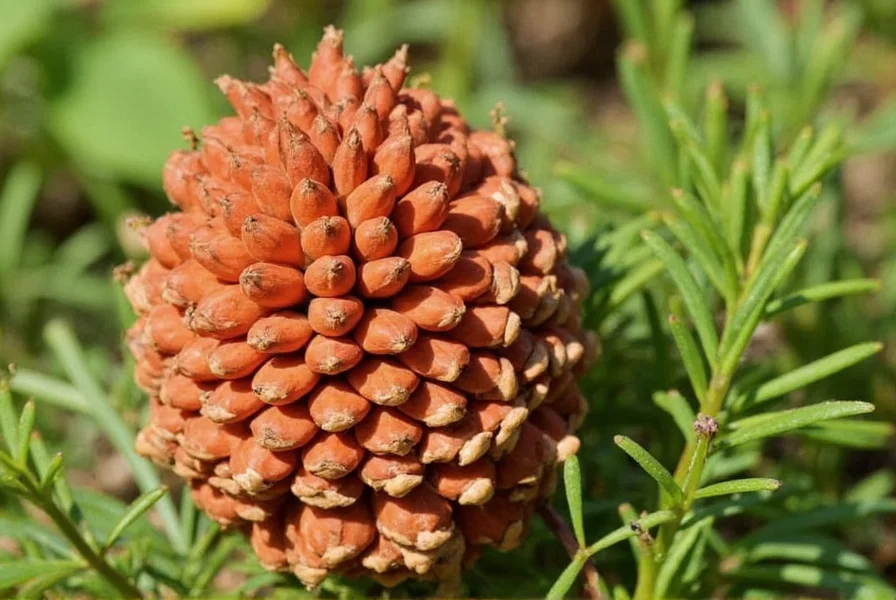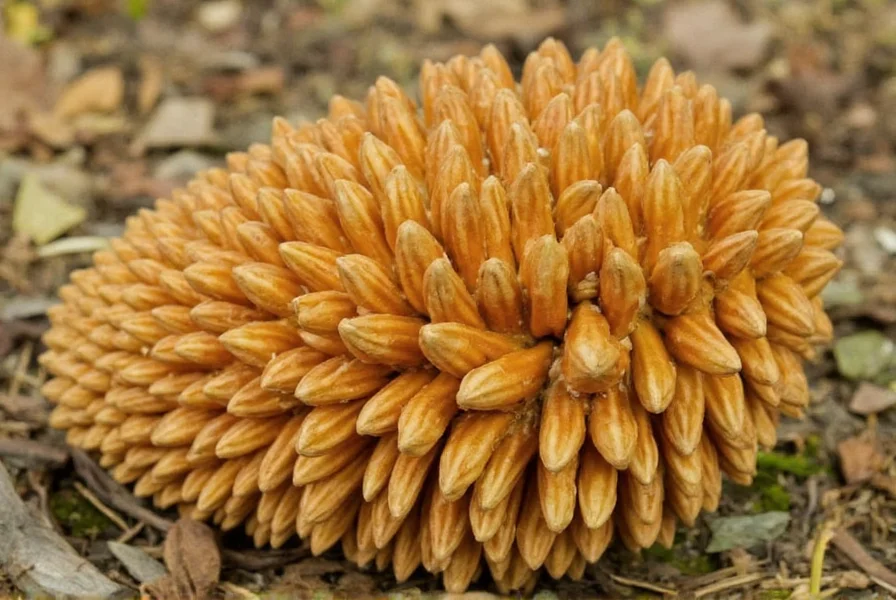Pinecone ginger, scientifically known as Zingiber zerumbet, stands as one of the most visually distinctive members of the Zingiberaceae family. This perennial herb reaches heights of 3-6 feet with lush green foliage and produces unique inflorescences that begin as tight green cones resembling pinecones, hence its common name. As these cones mature, they transition to a vibrant red hue and exude a clear, fragrant gel traditionally used as a natural shampoo—earning it the alternative name "shampoo ginger."

Botanical Characteristics and Identification
Understanding the specific features of pinecone ginger helps distinguish it from other ginger varieties. The plant features:
| Feature | Description |
|---|---|
| Rhizome | Less pungent than common ginger, with mild flavor; primarily used for propagation |
| Inflorescence | Cone-shaped (5-8 cm long), green maturing to red, producing aromatic gel |
| Foliage | Long, lance-shaped leaves (up to 18 inches) with prominent midrib |
| Flowering | Produces flowers from summer through fall in tropical climates |
| Gel secretion | Fragrant, viscous substance with traditional hair care applications |
Key Differences Between Pinecone Ginger and Common Ginger
Many gardeners and culinary enthusiasts confuse pinecone ginger with common ginger (Zingiber officinale), but significant differences exist between these two species. The most notable distinction lies in their primary useful components: common ginger's value comes from its spicy rhizome, while pinecone ginger's value centers on its floral cones and their gel secretion.
Unlike common ginger's knobby, fibrous rhizomes with intense heat, pinecone ginger produces smoother rhizomes with milder flavor, making them less suitable for culinary applications requiring strong ginger flavor. The visual difference in their flowering structures is dramatic—common ginger produces relatively inconspicuous flowers, while pinecone ginger's signature cones provide ornamental value and practical uses.
Cultivation Requirements for Pinecone Ginger
Growing pinecone ginger successfully requires understanding its tropical origins. Native to Southeast Asia and widely naturalized throughout the Pacific Islands, this plant thrives in USDA hardiness zones 8-11 but grows most vigorously in zones 10-11 where frost never occurs.
For optimal growth, provide:
- Partial shade to filtered sunlight (direct afternoon sun can scorch leaves)
- Rich, well-draining soil with high organic matter content
- Consistent moisture without waterlogging (drought tolerant once established)
- Warm temperatures between 70-90°F (21-32°C)
- High humidity levels (misting beneficial in dry climates)
Gardeners in temperate climates can grow pinecone ginger in containers, bringing plants indoors before temperatures drop below 50°F (10°C). The rhizomes multiply readily, allowing for easy propagation through division every 2-3 years when plants become crowded.
Traditional and Modern Applications of Pinecone Ginger
Across Pacific Island cultures, pinecone ginger has served multiple practical purposes for centuries. The fragrant gel extracted from mature cones traditionally functioned as a natural shampoo and hair conditioner, explaining its "shampoo ginger" moniker. This gel contains compounds that provide shine to hair while potentially offering antimicrobial benefits for the scalp.
Traditional medicinal applications include using the rhizome for digestive issues, inflammation reduction, and as a mild analgesic. Modern research has begun investigating Zingiber zerumbet's bioactive compounds, particularly zerumbone, which shows promising anti-inflammatory and antioxidant properties in preliminary studies.
Culinarily, while not as potent as common ginger, pinecone ginger rhizomes can flavor teas, soups, and stir-fries. The young shoots occasionally appear in salads, and the flower cones sometimes serve as decorative edible elements in tropical cuisine. However, its primary contemporary value remains ornamental and traditional rather than culinary.
Scientific Research on Pinecone Ginger Properties
Recent scientific interest in Zingiber zerumbet has focused on its unique phytochemical profile. Unlike common ginger's gingerols, pinecone ginger contains zerumbone as its principal bioactive compound. Laboratory studies indicate zerumbone demonstrates significant anti-inflammatory effects by inhibiting key inflammatory pathways.
Research published in the Journal of Ethnopharmacology (2023) documented zerumbone's potential in managing oxidative stress, while a Phytotherapy Research study (2022) highlighted its antimicrobial properties against certain bacterial strains. However, most research remains in preclinical stages, and human clinical trials are limited. Those considering pinecone ginger for therapeutic purposes should consult healthcare professionals rather than self-treating medical conditions.
Practical Considerations for Gardeners and Enthusiasts
When incorporating pinecone ginger into your garden or collection, consider these practical tips for success. The plant spreads through rhizome division, so provide adequate space (3-4 feet between plants) to accommodate its growth habit. In tropical climates, it can become somewhat invasive if not contained.
To harvest the signature gel, wait until cones turn from green to pinkish-red (typically 6-8 weeks after emergence). Gently squeeze mature cones to extract the fragrant substance. For culinary use, select young rhizomes with smooth skin and minimal fibrous texture. Remember that pinecone ginger's flavor profile differs significantly from common ginger, so adjust recipes accordingly when substituting.
Those interested in traditional hair care applications can create a simple preparation by collecting the gel from 5-6 mature cones, mixing with 2 tablespoons of water, and applying to damp hair before shampooing. This natural treatment provides shine without synthetic ingredients, though individual results may vary.
Conclusion
Pinecone ginger represents a fascinating botanical specimen that bridges ornamental, traditional, and potential therapeutic applications. Its distinctive appearance, cultural significance across Pacific regions, and unique properties differentiate it from more common ginger varieties. Whether grown for its striking floral cones, traditional hair care applications, or potential health benefits, Zingiber zerumbet offers gardeners and natural product enthusiasts a versatile tropical plant with multiple points of interest. As research continues to explore its bioactive compounds, pinecone ginger may gain increased recognition beyond its traditional uses while maintaining its status as a distinctive member of the ginger family.
What is the difference between pinecone ginger and common ginger?
Pinecone ginger (Zingiber zerumbet) differs from common ginger (Zingiber officinale) primarily in its useful components. Common ginger's value comes from its spicy rhizome, while pinecone ginger's value centers on its cone-shaped inflorescences that produce a fragrant gel. Pinecone ginger rhizomes have milder flavor, and the plants feature distinctive pinecone-like flower structures rather than the relatively inconspicuous flowers of common ginger.
Can you eat pinecone ginger? Is pinecone ginger edible?
Yes, pinecone ginger is edible but with important distinctions from common ginger. The rhizomes have a milder flavor and can be used in teas, soups, and stir-fries, though they lack the intense heat of common ginger. The young shoots occasionally appear in salads, and the flower cones can serve as decorative edible elements. However, the primary traditional use focuses on the fragrant gel from the cones for hair care rather than culinary applications.
How do you grow pinecone ginger in containers? Container gardening with pinecone ginger
To grow pinecone ginger in containers, select a pot at least 12-16 inches in diameter with excellent drainage. Use a rich, well-draining potting mix with added organic matter. Place in partial shade to filtered sunlight, keeping soil consistently moist but not waterlogged. Maintain temperatures above 50°F (10°C), bringing containers indoors before cold weather. Fertilize monthly during growing season with balanced organic fertilizer. Divide rhizomes every 2-3 years when plants become crowded.
What are the traditional uses of shampoo ginger in Pacific cultures?
In Pacific Island cultures, pinecone ginger (shampoo ginger) has served multiple traditional purposes. The fragrant gel extracted from mature cones functions as a natural shampoo and hair conditioner, providing shine while potentially offering antimicrobial benefits for the scalp. Medicinally, the rhizome has been used for digestive issues, inflammation reduction, and as a mild analgesic. The plant also holds ceremonial significance in some cultures and has been used as a natural dye source.
Does pinecone ginger have scientifically proven health benefits?
Preliminary scientific research shows promise for certain compounds in pinecone ginger, particularly zerumbone, which demonstrates anti-inflammatory and antioxidant properties in laboratory studies. Research published in the Journal of Ethnopharmacology (2023) documented potential benefits for managing oxidative stress. However, most studies remain in preclinical stages, and human clinical trials are limited. While traditional uses exist, pinecone ginger should not replace conventional medical treatments without professional healthcare guidance.











 浙公网安备
33010002000092号
浙公网安备
33010002000092号 浙B2-20120091-4
浙B2-20120091-4